

Compact Muon Solenoid
LHC, CERN
| CMS-PAS-TOP-18-003 | ||
| Search for standard model production of four top quarks in final states with same-sign and multiple leptons in proton-proton collisions at √s= 13 TeV | ||
| CMS Collaboration | ||
| March 2019 | ||
| Abstract: The standard model (SM) production of four top quarks (t¯tt¯t) is studied by the CMS Collaboration using proton-proton collision events collected in Run 2 of the CERN LHC, with a center-of-mass energy of 13 TeV and corresponding to an integrated luminosity of 137 fb−1. The events are required to contain a pair of same-sign leptons (e,μ) or at least three leptons, and several jets. Two approaches are used to enhance signal sensitivity: first a simple classification based on the number of jets and b-tagged jets, and second a boosted decision tree (BDT) taking advantage of kinematic variables related to leptons and jets. Control regions are used to constrain the dominant SM backgrounds. The two approaches find consistent results compatible with next-to-leading-order SM predictions. The observed (expected) significance of the BDT analysis is 2.6 (2.7) standard deviations, and the t¯tt¯t cross section is measured to be 12.6+5.8−5.2 fb. These results are used to constrain the Yukawa coupling of the top quark, yt, yielding a 95% confidence level limit of |yt/ySMt|< 1.7, where ySMt is the SM value of yt. Limits are also set on the production of a heavy scalar or pseudoscalar in a type II 2HDM scenario, with exclusions in the mass ranges of 350-470 GeV and 350-550 GeV for heavy scalar and pseudoscalar bosons, respectively, for the 2HDM scenarios considered. | ||
|
Links:
CDS record (PDF) ;
CADI line (restricted) ;
These preliminary results are superseded in this paper, EPJC 80 (2020) 75. The superseded preliminary plots can be found here. |
||
| Figures | |
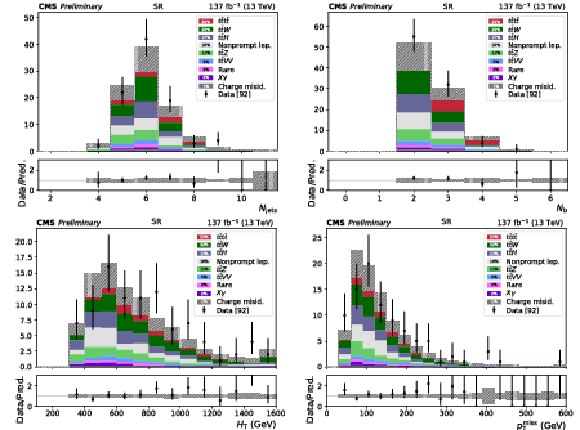
png pdf |
Figure 1:
Distributions in Njets (upper left), Nb (upper right), HT (lower left), and pmissT (lower right) in the signal regions summed (SR 1-14), before fitting to data, where the last bins include the overflows. The hatched areas represent the total uncertainties in the SM signal and background predictions. The tˉttˉt signal assumes the SM cross section from Ref. [1]. The lower panels show the ratios of the observed event yield to the total prediction. Bins without a data point have no observed events. |
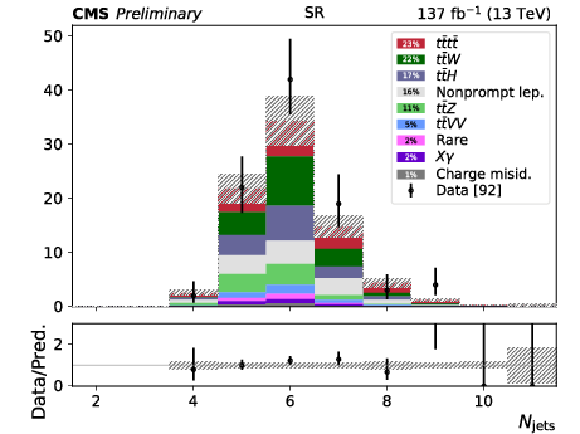
png pdf |
Figure 1-a:
Distributions in Njets (upper left), Nb (upper right), HT (lower left), and pmissT (lower right) in the signal regions summed (SR 1-14), before fitting to data, where the last bins include the overflows. The hatched areas represent the total uncertainties in the SM signal and background predictions. The tˉttˉt signal assumes the SM cross section from Ref. [1]. The lower panels show the ratios of the observed event yield to the total prediction. Bins without a data point have no observed events. |
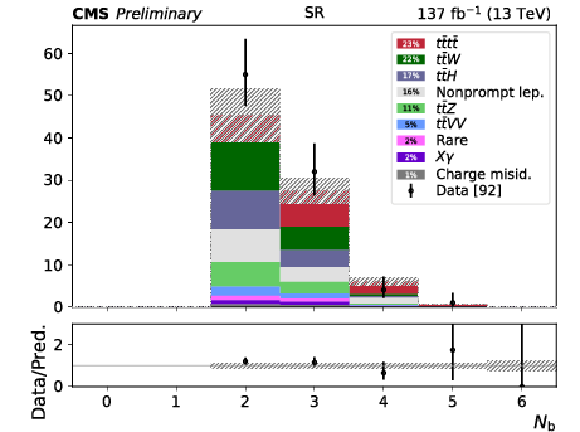
png pdf |
Figure 1-b:
Distributions in Njets (upper left), Nb (upper right), HT (lower left), and pmissT (lower right) in the signal regions summed (SR 1-14), before fitting to data, where the last bins include the overflows. The hatched areas represent the total uncertainties in the SM signal and background predictions. The tˉttˉt signal assumes the SM cross section from Ref. [1]. The lower panels show the ratios of the observed event yield to the total prediction. Bins without a data point have no observed events. |

png pdf |
Figure 1-c:
Distributions in Njets (upper left), Nb (upper right), HT (lower left), and pmissT (lower right) in the signal regions summed (SR 1-14), before fitting to data, where the last bins include the overflows. The hatched areas represent the total uncertainties in the SM signal and background predictions. The tˉttˉt signal assumes the SM cross section from Ref. [1]. The lower panels show the ratios of the observed event yield to the total prediction. Bins without a data point have no observed events. |
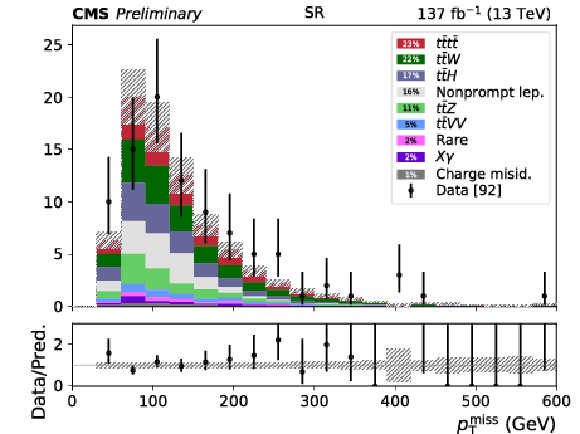
png pdf |
Figure 1-d:
Distributions in Njets (upper left), Nb (upper right), HT (lower left), and pmissT (lower right) in the signal regions summed (SR 1-14), before fitting to data, where the last bins include the overflows. The hatched areas represent the total uncertainties in the SM signal and background predictions. The tˉttˉt signal assumes the SM cross section from Ref. [1]. The lower panels show the ratios of the observed event yield to the total prediction. Bins without a data point have no observed events. |
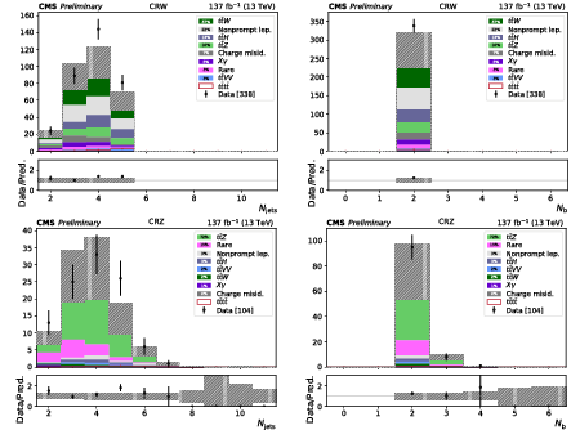
png pdf |
Figure 2:
Distributions in Njets and Nb in tˉtW (upper) and tˉtZ (lower) control regions, before fitting to data. The hatched area represents the uncertainty in the SM background prediction, while the solid line represents the overlaid tˉttˉt signal, assuming the SM cross section from Ref. [27]. The lower panels show the ratios of the observed event yield to the total background prediction. Bins without a data point have no observed events. |
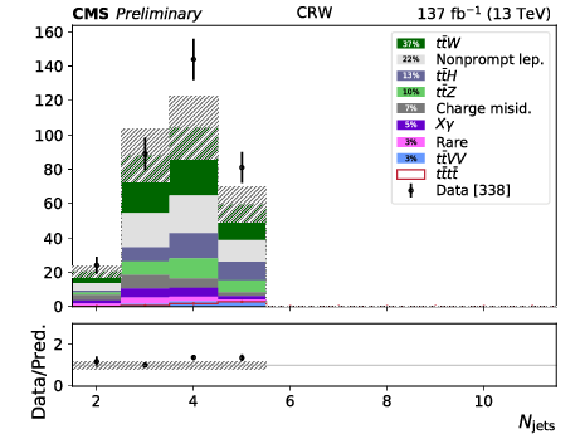
png pdf |
Figure 2-a:
Distributions in Njets and Nb in tˉtW (upper) and tˉtZ (lower) control regions, before fitting to data. The hatched area represents the uncertainty in the SM background prediction, while the solid line represents the overlaid tˉttˉt signal, assuming the SM cross section from Ref. [27]. The lower panels show the ratios of the observed event yield to the total background prediction. Bins without a data point have no observed events. |
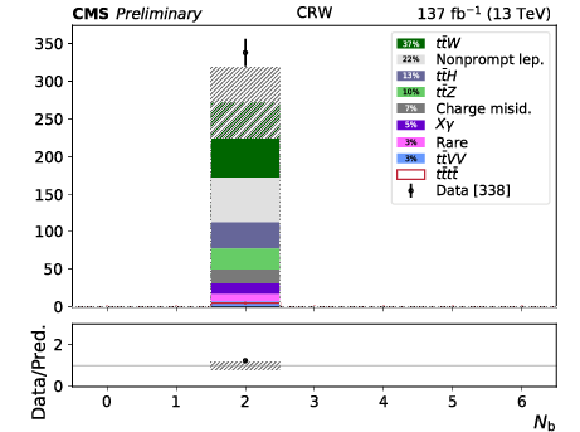
png pdf |
Figure 2-b:
Distributions in Njets and Nb in tˉtW (upper) and tˉtZ (lower) control regions, before fitting to data. The hatched area represents the uncertainty in the SM background prediction, while the solid line represents the overlaid tˉttˉt signal, assuming the SM cross section from Ref. [27]. The lower panels show the ratios of the observed event yield to the total background prediction. Bins without a data point have no observed events. |

png pdf |
Figure 2-c:
Distributions in Njets and Nb in tˉtW (upper) and tˉtZ (lower) control regions, before fitting to data. The hatched area represents the uncertainty in the SM background prediction, while the solid line represents the overlaid tˉttˉt signal, assuming the SM cross section from Ref. [27]. The lower panels show the ratios of the observed event yield to the total background prediction. Bins without a data point have no observed events. |

png pdf |
Figure 2-d:
Distributions in Njets and Nb in tˉtW (upper) and tˉtZ (lower) control regions, before fitting to data. The hatched area represents the uncertainty in the SM background prediction, while the solid line represents the overlaid tˉttˉt signal, assuming the SM cross section from Ref. [27]. The lower panels show the ratios of the observed event yield to the total background prediction. Bins without a data point have no observed events. |
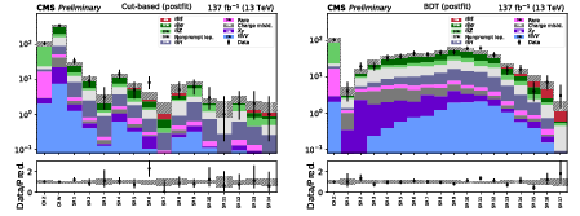
png pdf |
Figure 3:
Observed yields in the control and signal regions for the cut-based (left) and BDT (right) analyses, compared to the post-fit predictions for signal and background processes. The hatched areas represent the total post-fit uncertainties in the signal and background predictions. The lower panels show the ratios of the observed event yield and the total prediction of signal and background. |
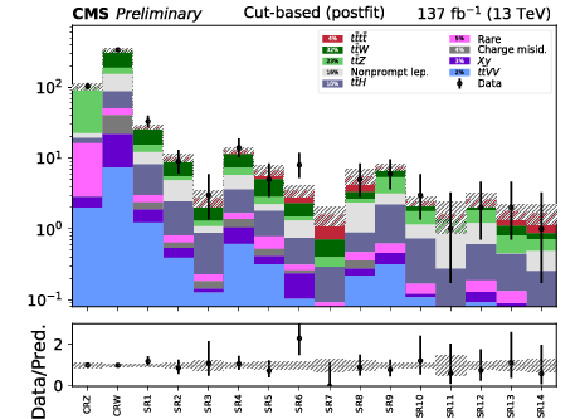
png pdf |
Figure 3-a:
Observed yields in the control and signal regions for the cut-based (left) and BDT (right) analyses, compared to the post-fit predictions for signal and background processes. The hatched areas represent the total post-fit uncertainties in the signal and background predictions. The lower panels show the ratios of the observed event yield and the total prediction of signal and background. |
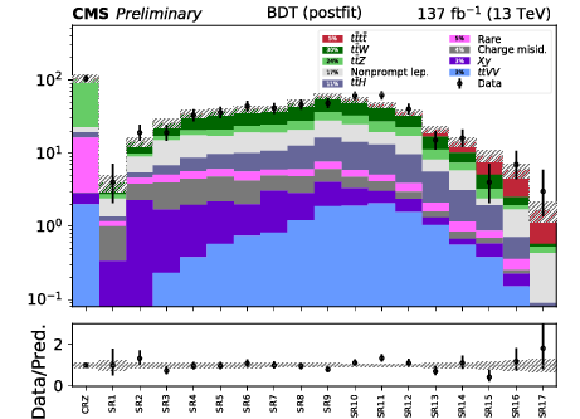
png pdf |
Figure 3-b:
Observed yields in the control and signal regions for the cut-based (left) and BDT (right) analyses, compared to the post-fit predictions for signal and background processes. The hatched areas represent the total post-fit uncertainties in the signal and background predictions. The lower panels show the ratios of the observed event yield and the total prediction of signal and background. |

png pdf |
Figure 4:
The predicted SM value of σ(pp→tˉttˉt) [2], calculated at LO and scaled to the 12.0+2.2−2.5 fb cross section obtained in Ref. [1], as a function of |yt/ySMt| (dashed line), compared with the observed value of σ(pp→tˉttˉt) (solid line), and with the observed 95% CL upper limit (hatched line). |

png pdf |
Figure 5:
Cross section limits, as a function of boson mass, for heavy scalar (left) and pseudoscalar (right) bosons, produced in association with one or two top quarks. The bosons subsequently decay to top quark pairs. The theoretical cross sections are shown with solid red lines. |
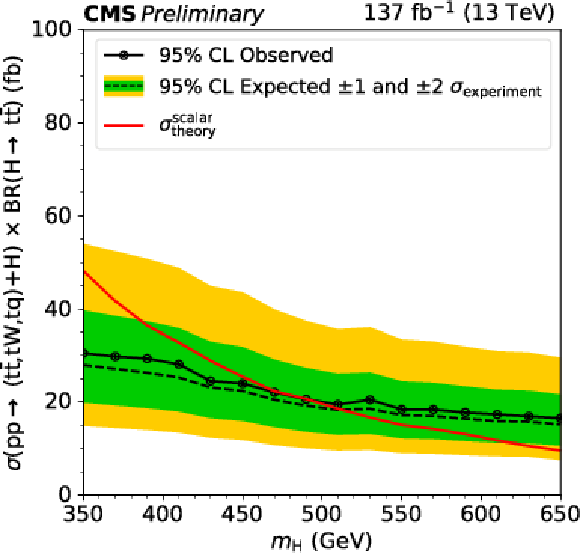
png pdf |
Figure 5-a:
Cross section limits, as a function of boson mass, for heavy scalar (left) and pseudoscalar (right) bosons, produced in association with one or two top quarks. The bosons subsequently decay to top quark pairs. The theoretical cross sections are shown with solid red lines. |
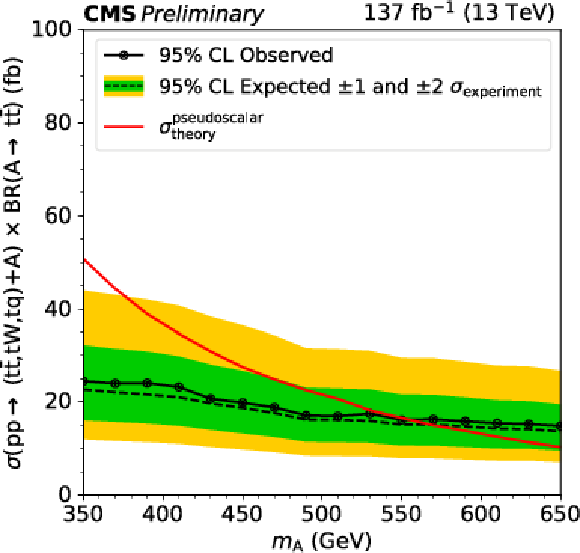
png pdf |
Figure 5-b:
Cross section limits, as a function of boson mass, for heavy scalar (left) and pseudoscalar (right) bosons, produced in association with one or two top quarks. The bosons subsequently decay to top quark pairs. The theoretical cross sections are shown with solid red lines. |
| Tables | |
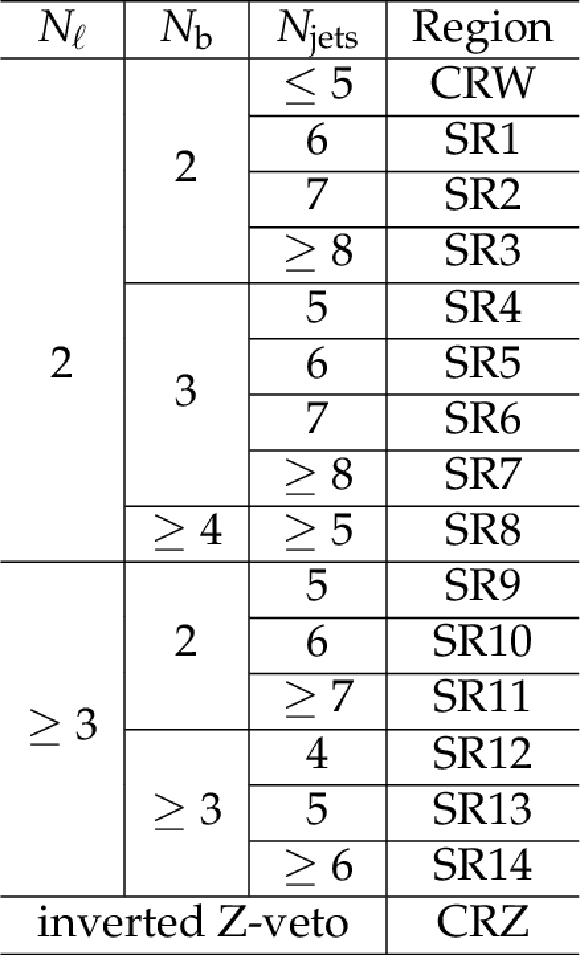
png pdf |
Table 1:
Definition of the 14 SRs and two CRs, CRW and CRZ, for the full Run2 cut-based analysis. |
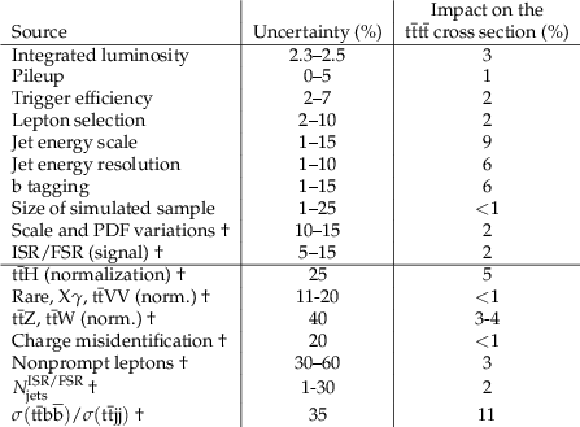
png pdf |
Table 2:
Summary of the sources of uncertainty and their effect on signal and background yields. The first group lists experimental and theoretical uncertainties in simulated signal and background processes. The second group lists normalization uncertainties in the estimated backgrounds. Uncertainties marked with a † in the first column are treated as fully correlated across the three years. |

png pdf |
Table 3:
The post-fit background, signal, and total yields with their total uncertainties and the observed number of events in the control and signal regions in data for the cut-based analysis. |
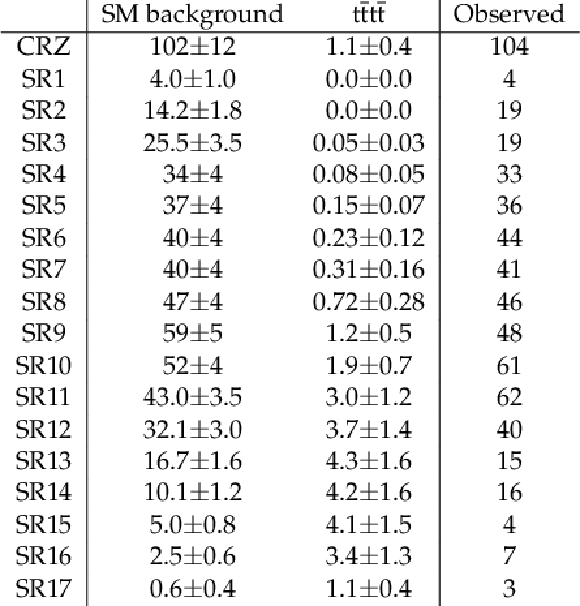
png pdf |
Table 4:
The post-fit background, signal, and total yields with their total uncertainties and the observed number of events in the control and signal regions in data for the BDT analysis. |
| Summary |
| The standard model (SM) production of tˉttˉt has been studied using data from √s= 13 TeV proton-proton collisions collected with the CMS detector during Run 2 of the LHC (2016-2018), corresponding to an integrated luminosity of 137 fb−1. The final state with two same-sign leptons or at least three leptons is analyzed with two strategies, the first relying on a cut-based categorization in lepton and jet multiplicity and jet flavor, the second taking advantage of a multivariate approach to distinguish the tˉttˉt from its many backgrounds. The multivariate strategy yields an observed (expected) significance of 2.6 (2.7) standard deviations relative to the background-only hypothesis, and a measured value for the tˉttˉt cross section of 12.6+5.8−5.2 fb, in agreement with the standard model prediction of 12.0+2.2−2.5 fb [1]. The cut-based strategy yields an observed (expected) significance of 1.7 (2.5) standard deviations relative to the background-only hypothesis, and a measured value for the tˉttˉt cross section of 9.4+6.2−5.6 fb, in agreement with the BDT result. The results of the BDT analysis are also used to constrain the top quark Yukawa coupling with respect to its SM value, based on the |yt| dependence of σ(pp→tˉttˉt) calculated at leading order in Ref. [2], resulting in a 95% confidence level limit of |yt/ySMt|< 1.7. Additionally, in Type II two-Higgs-double models, the analysis provides exclusions in the mass ranges of 350-470 GeV and 350-550 GeV for heavy scalar and pseudoscalar bosons, respectively. |
| References | ||||
| 1 | R. Frederix, D. Pagani, and M. Zaro | Large NLO corrections in tˉtW± and tˉttˉt hadroproduction from supposedly subleading EW contributions | JHEP 02 (2018) 031 | 1711.02116 |
| 2 | Q.-H. Cao, S.-L. Chen, and Y. Liu | Probing Higgs width and top quark Yukawa coupling from tˉtH and tˉttˉt productions | PRD 95 (2017) 053004 | 1602.01934 |
| 3 | Q.-H. Cao et al. | Limiting Top-Higgs Interaction and Higgs-Boson Width from Multi-Top Productions | 1901.04567 | |
| 4 | D. Dicus, A. Stange, and S. Willenbrock | Higgs decay to top quarks at hadron colliders | PLB 333 (1994) 126 | hep-ph/9404359 |
| 5 | N. Craig et al. | The hunt for the rest of the Higgs bosons | JHEP 06 (2015) 137 | 1504.04630 |
| 6 | N. Craig et al. | Heavy Higgs bosons at low tanβ: from the LHC to 100 TeV | JHEP 01 (2017) 018 | 1605.08744 |
| 7 | E. Alvarez et al. | Four Tops for LHC | NPB915 (2017) 19--43 | 1611.05032 |
| 8 | N. P. Hartland et al. | A Monte Carlo global analysis of the Standard Model Effective Field Theory: the top quark sector | 1901.05965 | |
| 9 | P. Ramond | Dual theory for free fermions | PRD 3 (1971) 2415 | |
| 10 | Y. A. Gol'fand and E. P. Likhtman | Extension of the algebra of Poincar\'e group generators and violation of P invariance | JEPTL 13 (1971)323 | |
| 11 | A. Neveu and J. H. Schwarz | Factorizable dual model of pions | NPB 31 (1971) 86 | |
| 12 | D. V. Volkov and V. P. Akulov | Possible universal neutrino interaction | JEPTL 16 (1972)438 | |
| 13 | J. Wess and B. Zumino | A lagrangian model invariant under supergauge transformations | PLB 49 (1974) 52 | |
| 14 | J. Wess and B. Zumino | Supergauge transformations in four-dimensions | NPB 70 (1974) 39 | |
| 15 | P. Fayet | Supergauge invariant extension of the Higgs mechanism and a model for the electron and its neutrino | NPB 90 (1975) 104 | |
| 16 | H. P. Nilles | Supersymmetry, supergravity and particle physics | PR 110 (1984) 1 | |
| 17 | S. P. Martin | A supersymmetry primer | in Perspectives on Supersymmetry II, G. L. Kane, ed., p. 1 World Scientific, 2010 Adv. Ser. Direct. High Energy Phys., vol. 21 | |
| 18 | G. R. Farrar and P. Fayet | Phenomenology of the production, decay, and detection of new hadronic states associated with supersymmetry | PLB 76 (1978) 575 | |
| 19 | T. Plehn and T. M. P. Tait | Seeking sgluons | JPG 36 (2009) 075001 | 0810.3919 |
| 20 | S. Calvet, B. Fuks, P. Gris, and L. Valery | Searching for sgluons in multitop events at a center-of-mass energy of 8 TeV | JHEP 04 (2013) 043 | 1212.3360 |
| 21 | Particle Data Group, C. Patrignani et al. | Review of Particle Physics | CPC 40 (2016) 100001 | |
| 22 | CMS Collaboration | Search for standard model production of four top quarks in proton-proton collisions at √s= 13 TeV | PLB 772 (2017) 336 | CMS-TOP-16-016 1702.06164 |
| 23 | ATLAS Collaboration | Search for new phenomena in events with same-charge leptons and b-jets in pp collisions at √s= 13 TeV with the ATLAS detector | JHEP 12 (2018) 039 | 1807.11883 |
| 24 | ATLAS Collaboration | Search for four-top-quark production in the single-lepton and opposite-sign dilepton final states in pp collisions at √s= 13 TeV with the ATLAS detector | Submitted to: PR(2018) | 1811.02305 |
| 25 | CMS Collaboration | Search for physics beyond the standard model in events with two leptons of same sign, missing transverse momentum, and jets in proton-proton collisions at √s= 13 TeV | EPJC 77 (2017) 578 | CMS-SUS-16-035 1704.07323 |
| 26 | CMS Collaboration | Search for standard model production of four top quarks with same-sign and multilepton final states in proton-proton collisions at √s= 13 TeV | EPJC78 (2018), no. 2, 140 | CMS-TOP-17-009 1710.10614 |
| 27 | J. Alwall et al. | The automated computation of tree-level and next-to-leading order differential cross sections, and their matching to parton shower simulations | JHEP 07 (2014) 079 | 1405.0301 |
| 28 | T. Melia, P. Nason, R. Rontsch, and G. Zanderighi | W+W−, WZ and ZZ production in the POWHEG BOX | JHEP 11 (2011) 078 | 1107.5051 |
| 29 | P. Nason and G. Zanderighi | W+W− , WZ and ZZ production in the POWHEG BOX V2 | EPJC 74 (2014) 2702 | 1311.1365 |
| 30 | D. de Florian et al. | Handbook of LHC Higgs cross sections: 4. deciphering the nature of the Higgs sector | CERN-2017-002-M | 1610.07922 |
| 31 | P. S. Bhupal Dev and A. Pilaftsis | Maximally Symmetric Two Higgs Doublet Model with Natural Standard Model Alignment | JHEP 12 (2014) 024 | 1408.3405 |
| 32 | NNPDF Collaboration | Parton distributions for the LHC Run II | JHEP 04 (2015) 040 | 1410.8849 |
| 33 | NNPDF Collaboration | Parton distributions from high-precision collider data | EPJC77 (2017), no. 10, 663 | 1706.00428 |
| 34 | T. Sjostrand, S. Mrenna, and P. Z. Skands | A brief introduction to PYTHIA 8.1 | CPC 178 (2008) 852 | 0710.3820 |
| 35 | J. Alwall et al. | Comparative study of various algorithms for the merging of parton showers and matrix elements in hadronic collisions | EPJC 53 (2008) 473 | 0706.2569 |
| 36 | R. Frederix and S. Frixione | Merging meets matching in MC@NLO | JHEP 12 (2012) 061 | 1209.6215 |
| 37 | GEANT4 Collaboration | GEANT4 --- a simulation toolkit | NIMA 506 (2003) 250 | |
| 38 | CMS Collaboration | Measurements of tˉt cross sections in association with b jets and inclusive jets and their ratio using dilepton final states in pp collisions at √s= 13 TeV | PLB776 (2018) 355--378 | CMS-TOP-16-010 1705.10141 |
| 39 | CMS Collaboration | The CMS experiment at the CERN LHC | JINST 3 (2008) S08004 | CMS-00-001 |
| 40 | CMS Collaboration | The CMS trigger system | JINST 12 (2017) P01020 | CMS-TRG-12-001 1609.02366 |
| 41 | CMS Collaboration | Particle-flow reconstruction and global event description with the cms detector | JINST 12 (2017) P10003 | CMS-PRF-14-001 1706.04965 |
| 42 | CMS Collaboration | Performance of electron reconstruction and selection with the CMS detector in proton-proton collisions at √s= 8 TeV | JINST 10 (2015) P06005 | CMS-EGM-13-001 1502.02701 |
| 43 | CMS Collaboration | Performance of CMS muon reconstruction in pp collision events at √s= 7 TeV | JINST 7 (2012) P10002 | CMS-MUO-10-004 1206.4071 |
| 44 | M. Cacciari, G. P. Salam, and G. Soyez | The anti-kt jet clustering algorithm | JHEP 04 (2008) 063 | 0802.1189 |
| 45 | M. Cacciari, G. P. Salam, and G. Soyez | FastJet user manual | EPJC 72 (2012) 1896 | 1111.6097 |
| 46 | CMS Collaboration | Jet energy scale and resolution in the CMS experiment in pp collisions at 8 TeV | JINST 12 (2016) P02014 | CMS-JME-13-004 1607.03663 |
| 47 | CMS Collaboration | Jet algorithms performance in 13 TeV data | CMS-PAS-JME-16-003 | CMS-PAS-JME-16-003 |
| 48 | CMS Collaboration | Identification of heavy-flavour jets with the CMS detector in pp collisions at 13 TeV | JINST 13 (2018), no. 05, P05011 | CMS-BTV-16-002 1712.07158 |
| 49 | CMS Collaboration | Performance of missing transverse momentum in pp collisions at sqrt(s)=13 TeV using the CMS detector | CMS-PAS-JME-17-001 | CMS-PAS-JME-17-001 |
| 50 | CMS Collaboration | Search for new physics in same-sign dilepton events in proton-proton collisions at √s= 13 TeV | EPJC 76 (2016) 439 | CMS-SUS-15-008 1605.03171 |
| 51 | CMS Collaboration | CMS Technical Design Report for the Pixel Detector Upgrade | CDS | |
| 52 | CMS Collaboration | CMS luminosity measurements for the 2016 data taking period | CMS-PAS-LUM-17-001 | CMS-PAS-LUM-17-001 |
| 53 | CMS Collaboration | Measurement of the inelastic proton-proton cross section at √s= 13 TeV | JHEP 07 (2018) 161 | CMS-FSQ-15-005 1802.02613 |
| 54 | CMS Collaboration | Observation of t¯tH production | PRL 120 (2018), no. 23, 231801 | CMS-HIG-17-035 1804.02610 |
| 55 | ATLAS and CMS Collaborations | Procedure for the LHC Higgs boson search combination in summer 2011 | ATL-PHYS-PUB-2011-011, CMS NOTE-2011/005 | |
| 56 | ATLAS Collaboration | Measurement of the tˉtZ and tˉtW cross sections in proton-proton collisions at √s= 13 TeV with the ATLAS detector | 1901.03584 | |
| 57 | CMS Collaboration | Measurement of the cross section for top quark pair production in association with a W or Z boson in proton-proton collisions at √s= 13 TeV | JHEP 08 (2018) 011 | CMS-TOP-17-005 1711.02547 |
| 58 | ATLAS Collaboration | Observation of Higgs boson production in association with a top quark pair at the LHC with the ATLAS detector | PLB784 (2018) 173--191 | 1806.00425 |
| 59 | CMS Collaboration | Precise determination of the mass of the Higgs boson and tests of compatibility of its couplings with the standard model predictions using proton collisions at 7 and 8 TeV | EPJC 75 (2015) 212 | CMS-HIG-14-009 1412.8662 |
| 60 | G. Cowan, K. Cranmer, E. Gross, and O. Vitells | Asymptotic formulae for likelihood-based tests of new physics | EPJC 71 (2011) 1554 | 1007.1727 |
| 61 | T. Junk | Confidence level computation for combining searches with small statistics | NIMA 434 (1999) 435 | hep-ex/9902006 |
| 62 | A. L. Read | Presentation of search results: the CLs technique | in Durham IPPP Workshop: Advanced Statistical Techniques in Particle Physics, p. 2693 Durham, UK, March, 2002 JPG 28 (2002) 2693 | |

|
Compact Muon Solenoid LHC, CERN |

|

|

|

|

|

|